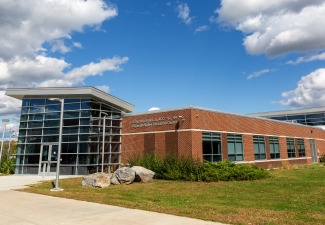SUNY Plattsburgh Students Win Award for Research on DNA Sequencing of Ancient Maya Skeletons
Melissa Kopp did not want to go to SUNY Plattsburgh.
She went to high school in a nearby community and longed to get away - to go out in the big wide world and be someone. She applied and was accepted elsewhere. Then, she was in an accident. That accident changed the way she viewed the world and made her want to return home.
So, after a semester, she returned to the area and started taking classes at SUNY Plattsburgh, where she found she was able to excel, not just locally but globally. Her only regret is that she did not come to the college in the first place.
There are amazing opportunities at SUNY Plattsburgh, and, for Kopp and fellow student Nishank Bhalla, those opportunities have included the chance to win top honors at an international research conference.
Winning Top Honors
Kopp, a senior in biochemistry and Bhalla, a sophomore in biology, took top honors at the 2007 Sigma Xi Student Research Conference. The two competed with more than 300 others from 92 colleges and universities.
They submitted projects based on their work with the skeletons of the ancient Maya - work conducted under the supervision of Associate Professor Dr. Nancy Elwess and Adjunct Lecturer Sandra Latourelle.
The college is home to the world's largest collection of these skeletons, excavated over the years by SUNY Distinguished Professor of Anthropology Mark Cohen, Ph.D.
SUNY Plattsburgh is also one of the few colleges that has a DNA sequencer. Access to both the skeletons and the sequencer opens up the door to a wide range of significant research possibilities for Plattsburgh's undergraduates.
Undergraduate Students Sequencing DNA
Bhalla and Kopp have been taking part in a type of research that has only been done a few times before and that has never been done by undergraduates. They have been working with DNA extracted from the teeth of the skeletons. They amplify the DNA, increasing the sample, so that they can sequence it and determine the ancestry of the deceased.
The two are specifically looking to see if any of the ancestors came from the Old World. This is important because the individuals appear to have suffered from Beta thalassemia, a genetic disorder that prevents the blood from carrying enough oxygen.
Beta thalassemia was thought to have been brought to the New World by the Spanish, but Kopp and Bhalla are finding that this may not be true. So far the genes of the skeletons they are synthesizing appear to be purely Maya. If this is case, the disorder may have been present in the New World before arrival of the Spanish.
The researchers at SUNY Plattsburgh are not able to make that claim yet, however. There is still much work to be done, according to Bhalla.
"We are still in the troubleshooting phase," he said.
In the meantime, the two are learning a great deal, forging new paths and benefiting from the self-directed approach the instructors have taken with them.
Taking Ownership of the Project
"They tell us to claim ownership of the project," said Bhalla who had a say in determining what project he wanted to work on as well as what protocols to use. "They give us freedoms and let us explore and find out for ourselves." This can lead to frustration. He added, "But they tell us that is a part of it."
Kopp ran into one such snag early in the project. For the first four months, she could not get her DNA to amplify.
"Since this was only the third time that studies have been done on ancient Mayas, we were on our own," said Kopp. She had to troubleshoot, trying different solutions until she solved the problem. According to Kopp, the day that she got it to work was a great day.
"I honestly think this has been one of the best experiences of my life," said Kopp who is a fan of SUNY Plattsburgh's science department. "A lot of students don't realize that there are these opportunities and you can excel in research here."
"The project has been a most amazing experience, in terms of learning so much more and actually discovering something new for the first time," said Bhalla.
The Place to Be
Both Kopp and Bhalla are thankful for the chance to work on such important projects.
"The college is small, but not too small," said Kopp.
She remembered her time at the other college and the size of the classes there, some with 250 people. "How do you compete with that?" said Kopp. "There are opportunities here. Your undergraduate years are what you make of them."
"I love this college so much," said Kopp. "It's a perfect fit. I would never transfer."
News

SUNY Adirondack Students Benefit from New Dual Agreement with SUNY Plattsburgh Queensbury
